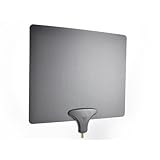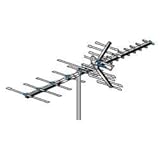 Lets face it the cost of Cable or Dish based Television is just getting out of hand. They get you to subscribe by offering amazing deals for the first few months or a year but often you are tied to contracts that require you to pay full price for months or years to come.
Lets face it the cost of Cable or Dish based Television is just getting out of hand. They get you to subscribe by offering amazing deals for the first few months or a year but often you are tied to contracts that require you to pay full price for months or years to come.
This is why so many people are deciding to go back to Over The Air television which has no monthly fee other than the cost to install an antenna and maybe upgrade your media center to capture shows for later viewing.
In addition to over the air HTDV you can also subscribe to paid internet based television and movies that can supplement your viewing options or go with free internet services that offer music, news and lots of other content that you just can’t get on Cable or Dish.
If you are a Sports fan you can even subscribe to MLB, NFL, NBA broadcasts and view them on your television just like you do now.
But lets get back to Over The Air Television because its free and its your first step to saving lots of money on home entertainment.
Selecting the Right Antenna for Over The Air HDTV
If you are like most of America or the world now you have already started the transition to HDTV. In our home we have a couple Televisions that are Flat Screen and although we subscribe to basic cable and do not have HD as an option the tuners inside the Televisions are capable of capturing and displaying HD Quality TV.
To display HDTV we would have to upgrade every set top box in the house and subscribe to a more expensive Cable plan for an approximate increase of about $80 a Month. Yes that is a bit crazy and what is even worse is many of the local channels including FOX, NBC, CBS, ABC, ION, TheCW and others broadcast their signals in HD and then our Cable TV company downgrades that signal to garbage to send out to our home and charge us an amazing amount of money for nothing…
So, the first thing you need is your Television. It must be able to display HD in 720i, 720p, 1080i, 1080p formats.
The second thing you need is an antenna that can get you those signals for free.
Now every TV has an internal VHF,UHF antenna but if you live more than about 10 miles outside of your city or if the area you live in blocks your direct line of site to the broadcast towers you will need an add-on Antenna.
There are tons of options for Antennas but we are going to break it down into a few selections that will let you understand what you need and if it is worth the trouble for you. Lets face it the reason so many people are on Cable is not for the content but because we were convinced about how easy it is.. so lets get started.
Antenna Selection for Suburban Residents
 If you live in the suburbs of a large city the television signal in your area is probably pretty great. As we said above you can most likely receive most of the major networks over the air and possibly without an external antenna.
If you live in the suburbs of a large city the television signal in your area is probably pretty great. As we said above you can most likely receive most of the major networks over the air and possibly without an external antenna.
If you do need an external antenna to pick up a few weaker signals you should take a look at the smaller wall mounted antennas that can sit behind your television or possibly behind a picture hanging on the outside wall of your home. You can even get a plastic film based antenna that will mount on a window and still let light through. They aren’t real pretty but if they help you get a few more stations you will quickly learn to live with it.
When you install set top antennas each of your TVs will require its own antenna and depending on the position in the house and what floor you are on you might not get any reception. This can be true for basements.
Antennas for Distant Suburban or Near Rural Homes
Just living in a City Setting or suburban area near a city does not guarantee that you will have good television reception. You might actually find yourself in the same situation as the next group of television watchers … people that live on the edges of suburban communities.
Once you have tried the internal antennas in your television and stepped up to an external desktop or wall mount antenna your next option is an attic mounted antenna.
Now mounting your antenna in your attic is really up to you but there are some advantages of this type of configuration over a roof mounted antenna or a tower mounted antenna. However if you find that this option won’t work for you then you will need to go outside.
Because Radio or TV Broadcast Signals can penetrate your home’s building materials placing an antenna in your attic will work well for many people.
By raising the antenna off of ground level you will increase the probability that radio waves can pass through the antenna. Most antenna installers say that anything under about 10 feet off the ground is basically useless.
If you are putting an antenna in your attic you will need to decide which direction to point it. If you are like most people you will find that 70% of your TV Station Broadcast towers are in one direction and a few are in opposite directions. Since TV antennas are normally directional it means you need to point the antenna at those broadcast towers.
Your other option is to install the antenna on a motorized remote control antenna rotatorsthat you can control in a lower level of your home to watch those few stations by changing the antenna’s direction.
But if you split the antenna signal to more than one TV you will hear screams of outrage when turning the antenna shuts off signals to other household members favorite shows.
Installing Two Antennas is your next option and you can distribute the Antenna Signal on the Coax Cable that is already being used for your Cable TV or Dish once you disconnect it from those systems. You can not attach an antenna to an active Cable TV or Dish cable line because you could cause damage to your property or even to the Cable TV Network Equipment.
What Antenna is best for people out in the middle of nowhere?

If you are distant from TV Broadcast Towers or if the area you live in has terrain that blocks the signals you will need to resort to some dramatic measures.
Normally this area is referred to as the Fringe and if you live in this area like I do you may find that you will need to get signals from more than one direction to get a standard lineup that suburban and city homes don’t think twice about. For instance I get most of my signals to the north but Fox is to my south and ABC is to the West. If I want to watch those networks I need to install 3 antennas that won’t interfere with each other or I will need a antenna rotator that will cut off signal to my primary group of channels whenever I want to watch just a couple channels in the other directions.
So far I have decided to mount my antenna in my attic but unlike other locations closer to broadcast towers my antenna requires a powered amplifier to receive any signals in any direction.
More specifically I am using a PreAmp amplifier that is built into a small antenna about 1 meter x 1 meter in size. I believe that if I was to go to a much larger 80 inch or 55 inch antenna I would still need an amplifier for most of the stations that I can pickup now but I could probably pickup a handful of stations without amplification.
If I lived just a little bit farther away maybe 30 miles I would need a large antenna mounted externally on a Tower to receive any signals.
Final Note on HDTV Antenna Selection
So we have looked at our options and found that there are basically 4 different situations that require both larger antennas and powered amplification.
Amplification can not on its own overcome distance or size of your antenna but in many situations its like turning on a light.. You will get signal or you won’t with amplifiers.
There are Four basic kinds of antennas you want to look for.
First for people close to broadcast towers simply try the internal antenna you might be fine.
Second is a wall mount antenna that may or may not be amplified but remember this those antennas are not the same as a regular amplified antenna. If you see a small square box that you stick on the wall and they are telling you its amplified well don’t expect to use that if you are on the edge of town 40 to 50 miles away.
The third is the type of antenna I use. It is a more modern and smaller antenna that actually uses a high power amplifier. With this antenna you can normally get signal up to about 60 miles with very good results and maybe up to 90 miles with limited success in good weather. And I am in a very flat area so the conditions are very optimal.
The final type is a large antenna with rotation and amplification. These antennas can be mounted on your home if you are up to 70 miles away or on a tower if you are farther away. If you live in a area with mountains then you will need to see if you can bounce the signal and that might mean not pointing directly at a tower.
Remember find the signal strength that is required to receive signal in your area for a specific station.
Then find a way to generate that many DBs .. all antennas are rated in db’s . My antenna is 36db with the amplifier on. This is 3 times stronger then most very large antennas without an amplifier.
Check our other howtos on antennas and media systems for your home. You might be surprised that all you will be missing is that big bill every month.
